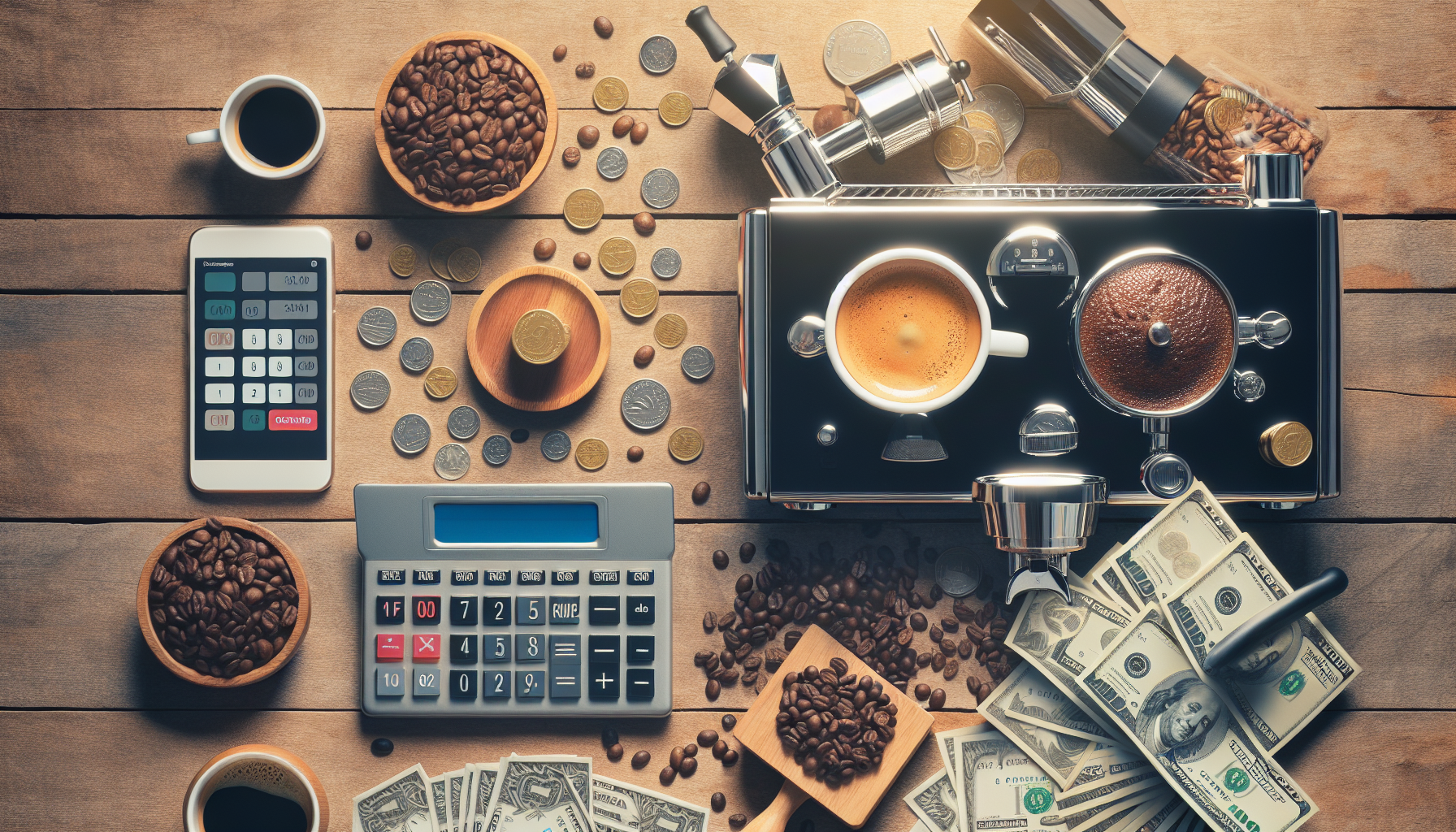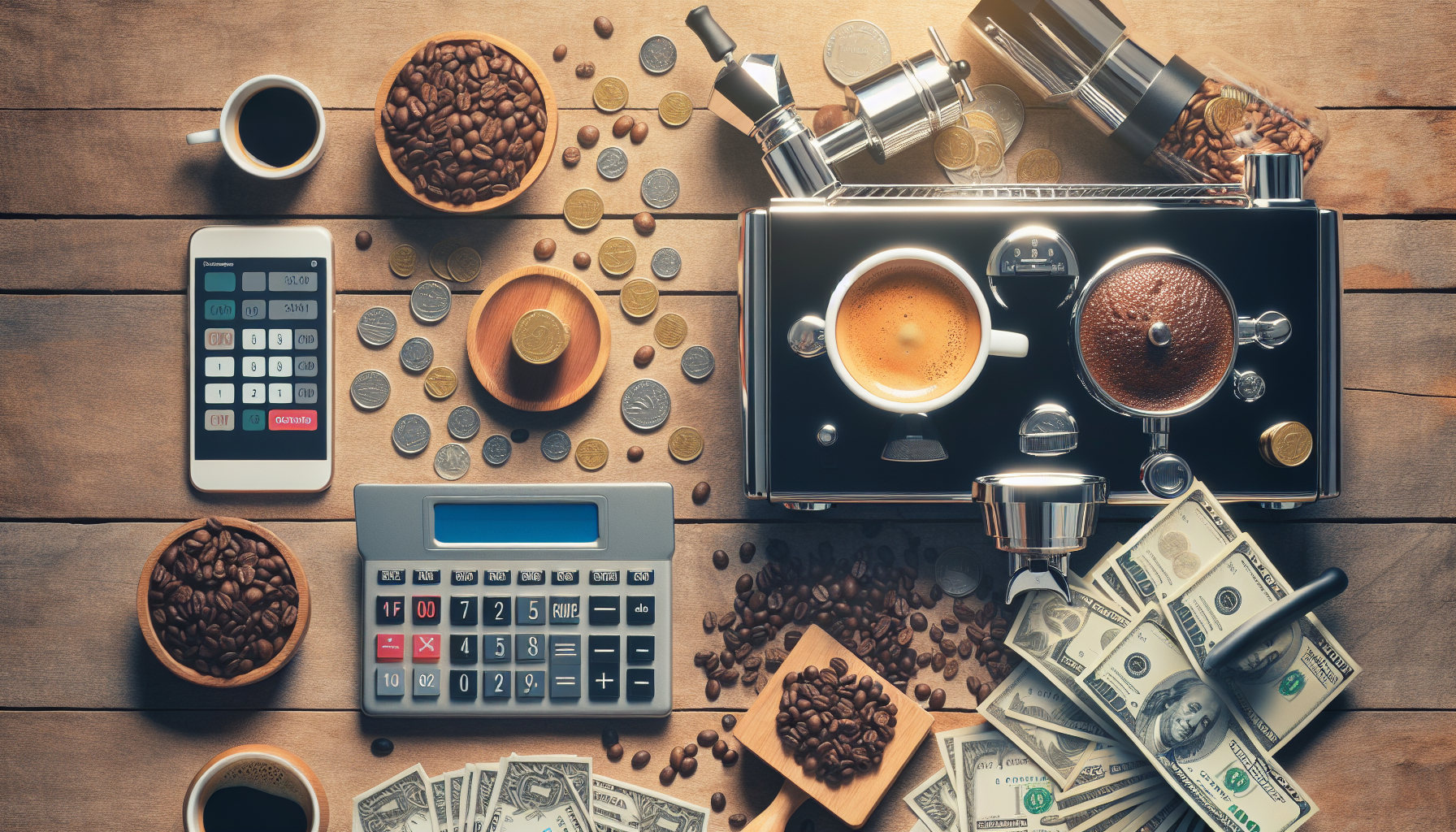Let’s settle the debate once and for all – is it actually cheaper to make your own espresso? Many coffee enthusiasts have pondered this question as they stand in line at their local cafes, contemplating the potential savings from investing in an at-home espresso machine. In this article, we will explore the financial implications of brewing your own espresso and uncover whether it’s truly a money-saving venture. So grab a cup of your favorite coffee, sit back, and let’s break down the numbers together.

CHECK OUT ESPRESSO MACHINES ON AMAZON
The Cost of Espresso Machines
Entry-level espresso machines
If you’re new to making espresso at home, an entry-level machine is a great option to consider. These machines tend to be more affordable, usually ranging from around $100 to $300. While they may not have all the bells and whistles of higher-end machines, they are capable of producing a decent shot of espresso. They typically have basic features such as a steam wand for frothing milk and the ability to adjust the brew temperature. These machines are a good starting point for those who want to experiment with making espresso at home without breaking the bank.
Mid-range espresso machines
For those looking for more advanced features and better quality, mid-range espresso machines are a good choice. These machines typically range from $300 to $1000. With mid-range machines, you can expect better temperature stability, more precise control over the brewing process, and higher build quality. They often come with features such as programmable settings, PID temperature control, and a larger water reservoir. This makes them a popular choice for espresso enthusiasts who want more control over their brewing process without jumping into the high-end price range.
High-end espresso machines
If you’re passionate about espresso and have a higher budget, high-end espresso machines offer the best in terms of quality and customization. These machines can range from $1000 to several thousand dollars. High-end machines are designed with precision and durability in mind. They often come with advanced features such as dual boilers for simultaneous brewing and steaming, pressure profiling to control the extraction process, and built-in grinders for a truly professional experience. These machines are often used by coffee professionals and enthusiasts who are willing to invest in the best equipment for their espresso brewing journey.
The Cost of Coffee Beans
Whole bean vs. pre-ground
When it comes to the cost of coffee beans, there are a few factors to consider. Firstly, purchasing whole bean coffee tends to be cheaper in the long run compared to pre-ground coffee. Whole bean coffee retains its freshness for longer, as grinding the beans right before brewing helps to preserve the flavors and aromas. Pre-ground coffee, on the other hand, tends to lose its freshness more quickly, resulting in a less flavorful cup of espresso. While whole bean coffee may require an upfront investment in a grinder, the overall quality and taste make it a worthwhile choice.
Single-origin vs. blends
Another factor to consider is the type of coffee beans you choose. Single-origin coffee beans are sourced from a specific region or farm, resulting in a unique flavor profile. While they can be more expensive than blends, single-origin beans offer an opportunity to explore different flavors and experiences. Blends, on the other hand, are a combination of different beans and are often more affordable. They offer a consistent taste and are a popular choice for those seeking a well-balanced cup of espresso without breaking the bank.
Organic and specialty beans
Organic and specialty beans are usually priced higher than conventional coffee beans. Organic beans are grown without the use of synthetic pesticides or fertilizers, making them a more sustainable and environmentally-friendly choice. Specialty beans, on the other hand, are considered to be of higher quality and are sourced from specific farms or regions known for producing exceptional coffee. While these beans may come with a higher price tag, they often offer a more unique and flavorful espresso experience.
Additional Equipment and Accessories
Grinders
Investing in a good quality grinder is essential for achieving the best flavor and consistency in your espresso. Grinders can range from manual hand grinders to electric burr grinders, with prices varying accordingly. While high-end grinders can be quite expensive, they offer more precision and control over the grind size, resulting in better extraction and flavor in your espresso. Consider your budget and brewing preferences when choosing a grinder, as it can greatly impact the overall quality of your espresso.
Tampers
Tampers are used to compress the coffee grounds in the portafilter, ensuring even extraction and a balanced flavor. While some espresso machines come with a tamper, they are often of lower quality. Investing in a good quality tamper that fits your portafilter size can improve the consistency and quality of your shots. Tampers come in various materials such as stainless steel or wood, with prices ranging from affordable to more luxurious options.
Milk frothing pitchers
If you enjoy milk-based espresso drinks such as lattes or cappuccinos, a milk frothing pitcher is a worthwhile investment. These pitchers come in various sizes and materials, with stainless steel being a popular choice for its durability and ease of cleaning. Prices for milk frothing pitchers can vary depending on the size and brand, but investing in a quality pitcher can enhance your milk frothing technique and result in beautifully textured milk for your drinks.
Espresso cups
While espresso cups may seem like a small detail, they can greatly enhance your overall coffee experience. Espresso cups are designed to retain heat better and showcase the crema and color of your espresso. They come in various sizes and materials, from classic ceramic to more modern glass or stainless steel options. Prices for espresso cups can vary depending on the brand and material, with options available for all budgets.
Cleaning supplies
Proper maintenance and cleaning of your espresso machine is crucial for its longevity and performance. Investing in cleaning supplies such as descaling solutions, group head brushes, and cleaning tablets will ensure that your machine stays in top shape. While the cost of these supplies may be small compared to the initial investment in the machine itself, they are necessary for keeping your espresso machine running smoothly and producing the best-tasting espresso.
The Price of Consumables
Espresso pods and capsules
If you prefer the convenience of espresso pods or capsules, it’s important to consider the cost of these consumables. While they offer easy and mess-free brewing, they can be more expensive compared to using whole bean coffee. The price per pod or capsule can vary depending on the brand and type of coffee, but it typically adds up over time. If cost is a concern, opting for whole bean coffee and grinding it yourself can be a more economical choice in the long run.
Milk and alternative milk products
Another factor to consider is the cost of milk or alternative milk products. If you enjoy milk-based espresso drinks, the cost of purchasing milk can add up over time. Additionally, if you prefer alternative milk products such as almond milk or soy milk, these tend to be more expensive compared to regular dairy milk. While the cost may not be significant for occasional home brewing, it’s worth considering if you consume a larger volume of espresso drinks.
Sweeteners and flavorings
If you enjoy adding sweeteners or flavorings to your espresso drinks, these can also contribute to the overall cost. Sugar, syrups, and other flavorings can be purchased separately and can vary in price depending on the brand and type. While these add-ons may not significantly impact the overall cost of making your own espresso, it’s important to consider them if you prefer customized and flavored drinks.
Energy Consumption
Electricity usage
Espresso machines require electricity to operate, and it’s important to consider the energy consumption when evaluating the overall cost. Higher-end machines with more advanced features and larger boilers tend to consume more energy compared to entry-level machines. However, keep in mind that the energy consumption also depends on how frequently you use the machine and for how long. If you’re concerned about electricity usage, choosing an energy-efficient machine or opting for lower power modes can help reduce your energy costs.
Standby mode and energy-saving features
Many espresso machines come with standby modes or energy-saving features that help reduce energy consumption when the machine is not in use. These features can include automatic shut-off timers, low-power modes, or sleep modes. By utilizing these features, you can further minimize energy consumption and potentially save on electricity costs over time. When researching espresso machines, it’s worth considering the energy-saving options and how they align with your energy efficiency goals.
Maintenance and Repairs
Regular cleaning and maintenance
Regular cleaning and maintenance are essential for keeping your espresso machine in optimal condition. This includes tasks such as descaling, backflushing, and cleaning the steam wand and brew group. While these tasks may require some time and effort, they are necessary to prevent the build-up of coffee oils, mineral deposits, and bacteria. Neglecting regular maintenance can lead to performance issues and potential breakdowns, which may result in costly repairs. By investing time in proper cleaning and maintenance, you can extend the lifespan of your machine and minimize future repair costs.
Repair costs and warranties
Despite regular maintenance, there may be instances where your espresso machine requires repairs. Repair costs can vary significantly depending on the type of issue, the brand, and the age of the machine. High-end machines often come with warranties that cover repairs within a certain period, whereas entry-level machines may have limited warranty coverage. It’s important to factor in potential repair costs when evaluating the overall cost of owning an espresso machine. Choosing a reputable brand with good customer support can help minimize repair costs and ensure a positive ownership experience.
Time and Convenience
Brewing time
Making espresso at home requires some time and patience. The brewing process involves grinding the coffee, tamping it, brewing the shot, and cleaning up afterward. The time it takes to make a shot of espresso can vary depending on the machine and your brewing technique. Entry-level machines may have slower heating times and require more manual effort, whereas high-end machines can offer faster and more automated brewing processes. When considering the convenience of making your own espresso, it’s important to factor in the additional time it takes compared to grabbing a quick drink at a coffee shop.
Waiting time
In addition to the brewing time, there may be waiting times between shots or between brewing and steaming milk. Entry-level machines may require additional time to heat up or cool down between tasks, whereas higher-end machines often offer faster heat-up times and simultaneous brewing and steaming capabilities. If time is a concern, investing in a machine that offers faster heating and brewing times can help minimize waiting and make the brewing process more convenient.
Ease of use and learning curve
The ease of use and learning curve of an espresso machine should also be considered. Entry-level machines tend to have simpler controls and require less technical knowledge, making them more beginner-friendly. On the other hand, high-end machines may have more advanced features and settings that require a learning curve to fully utilize. If you’re new to making espresso at home, consider your comfort level with learning new skills and operating more complex machines. Choosing a machine that suits your experience level can make the process more enjoyable and convenient.
Environmental Impact
Packaging waste
When considering the environmental impact, it’s important to consider the packaging waste associated with making your own espresso. Purchasing whole bean coffee often means less packaging waste compared to pre-ground coffee or single-use espresso pods. Opting for larger bags of coffee or purchasing from local roasters who use eco-friendly packaging can further minimize waste. Additionally, investing in reusable coffee filters, stainless steel pods, or compostable capsules can also reduce your environmental footprint.
Coffee grounds and composting
Another environmental consideration is the disposal of coffee grounds. Coffee grounds can be composted, which reduces waste and contributes to healthier soil. Composting coffee grounds not only diverts waste from landfills but also provides a nutrient-rich addition to compost piles or gardens. By making your own espresso at home, you have the opportunity to control and utilize the coffee grounds in an eco-friendly way.
Energy efficiency
The energy efficiency of your espresso machine can also have an impact on the environment. Higher-end machines may have more advanced energy-saving features, helping to reduce overall energy consumption. Additionally, investing in energy-efficient appliances, such as automatic shut-off power strips, can contribute to minimizing energy waste. When selecting an espresso machine, consider the energy efficiency ratings and features that align with your sustainability goals.
CHECK OUT ESPRESSO MACHINES ON AMAZON
Quality and Customization
Control over brewing process
Making your own espresso gives you full control over the brewing process, allowing you to customize the taste and strength of your coffee. With an espresso machine, you can adjust variables such as grind size, water temperature, and extraction time to achieve your desired flavor profile. This level of control is often not possible when purchasing coffee from a shop, as the brewing process is already standardized. By making your own espresso, you can experiment with different recipes and techniques to create a cup of coffee that perfectly suits your taste preferences.
Freshness and flavor
One of the biggest advantages of making your own espresso is the freshness and flavor of the coffee. Whole bean coffee retains its freshness for longer, and grinding the beans right before brewing ensures that you get the maximum flavor and aroma from the coffee. Additionally, by experimenting with different coffee beans and origins, you can explore a wide range of flavors and discover your favorites. The freshness and flavor of home-brewed espresso can rival or even surpass that of coffee shops, making the investment in an espresso machine worthwhile for coffee lovers.
Customizing strength and taste
A significant benefit of making your own espresso is the ability to customize the strength and taste of your coffee. Whether you prefer a bold and intense shot or a milder cup, you have full control over the amount of coffee used and the extraction time. This flexibility is not always possible when purchasing coffee from a shop, where the standard recipes cater to a wider audience. By making your own espresso, you can fine-tune your brewing technique to suit your personal preferences and create a consistently satisfying cup of coffee.
Comparison to Coffee Shop Prices
Cost per cup
When comparing the cost of making your own espresso to purchasing from a coffee shop, it’s important to consider the cost per cup. Making your own espresso can be significantly cheaper in the long run, especially if you enjoy multiple cups of coffee per day. While the initial investment in an espresso machine may be higher, the cost of coffee beans and other consumables tends to be lower compared to purchasing individual cups from a coffee shop. By making your own espresso, you can save money while still enjoying high-quality coffee.
Total savings over time
In addition to the cost per cup, it’s worth considering the total savings over time when making your own espresso. The upfront investment in an espresso machine may seem daunting, especially for higher-end machines. However, when compared to the cost of purchasing coffee from a shop on a regular basis, the savings can add up significantly over time. By calculating the cost of purchasing coffee versus the cost of making your own, you can determine the potential savings over months or even years. Making your own espresso can be a cost-effective option for coffee enthusiasts who enjoy the convenience of brewing at home.

